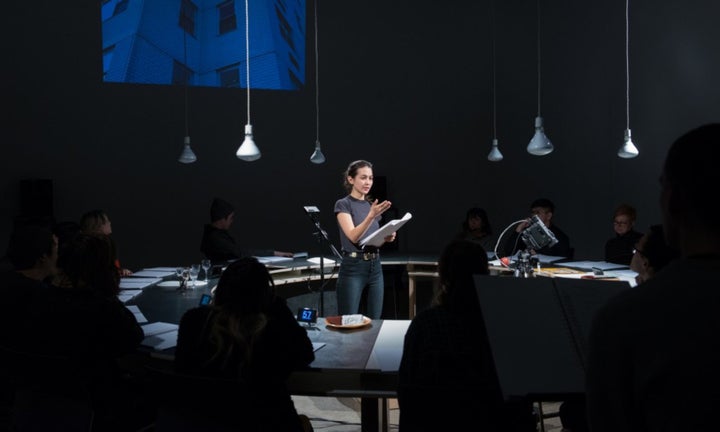
In a digital world, a wire recording seems not only archaic but nearly fictional. What does one do with a found estate sale wire recording capturing hours of intimate conversations from an unknown family in the 1950s? Performance artist Alison S.M. Kobayashi and UnionDocs co-founder Christopher Allen answer this question in their collaborate immersive performance Say Something Bunny!, which sits comfortably at the juncture of historical research, fiction, documentary, and performance art. The work was initially performed in Toronto in 2016 and premiered in New York City May 2017.
Presented in the form of a table reading, Kobayashi invites the audience to dig with the same impassioned curiosity she herself had in the years she transcribed and researched the Jewish Long Island family on the recording. In an act akin to anatomical dissection or literary interpretation, she peels back layers of the conversation carefully and expertly, separating strands of group conversations and background utterances— even deciphering the fact that some characters might actually be beloved pets. In doing so, she uncovers family ties and strains betrayed by both what is being said and left unsaid.
Using the original audio, she draws you into her immersive performance with props and original objects that evoke the time period. Kobayashi’s success turns on both her extensive, iterative approach to her research as well as her charismatic ability to commit herself completely to reenactments of dozens of characters from the audio— from a Jewish grandfather who sings Yankee Doodle Dandy to a rendition of Liza Minnelli.
Her performance makes a brave— and successful—counterpoint to the marked solipsism and fleeting nature of how we memorialize our conversations and experiences in the modern digital age— whether through selfies, passing tweets, or digital snapshots that we never return to. Her performance infuses new life into what otherwise might be an easily overlooked piece of personal ephemera that gets thrown out in the trash when a new family moves into a house. She gets the audience to care about strangers who are long gone. Some of the more humorous moments of the audio involve meta-conversations around the broken recorder and whether the wire recorder itself was a misguided purchase.
Kobayashi and Allen’s work gently hints at the inevitability of our own mortality, the passing relevance of our own attempts to document and memorialize moments of our lives, and our wish to keep our connections with others alive by recording them. She asks, “Did this family ever get to listen to this recording again? Perhaps.” But the wire recorder was broken when it was found at the estate sale, so it’s unclear any of the family members were ever able to listen to these family gatherings again.
At its heart, their work offers us the rare but possible promise that perhaps years— even decades— after we are also long gone, that a complete stranger may take time to get to listen to and get to know us, with wonder and imagination.
Performances of Say Something Bunny! run until end of July 2017 in New York City, tickets here.
